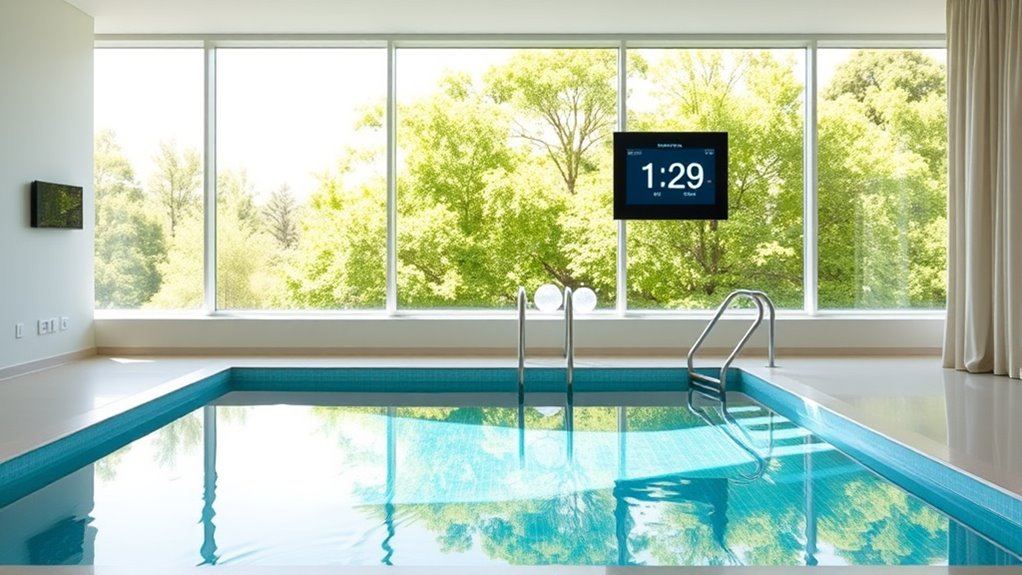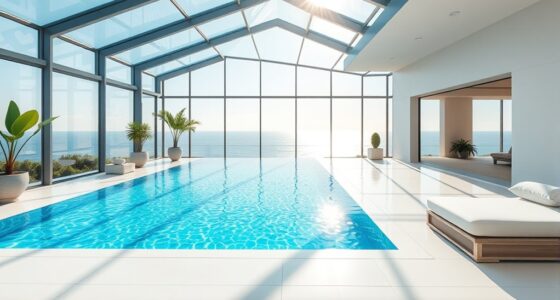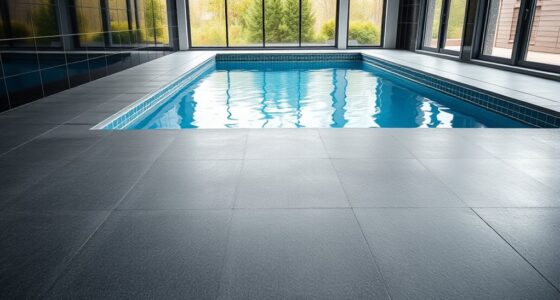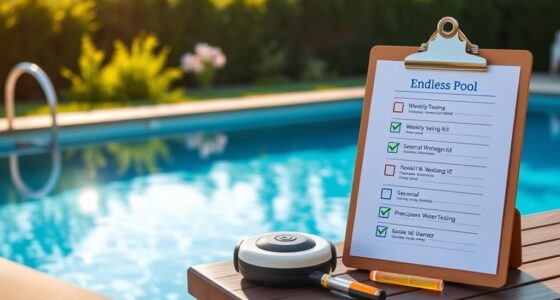Endless pools typically use between 1.5 and 4.0 kWh of power per hour, depending on their size, features, and energy efficiency measures. Smaller, basic models will use less energy, while larger or feature-rich pools consume more. To cut costs, you can upgrade to energy-efficient pumps, use insulated covers, and optimize usage schedules. For more tips on controlling your pool’s power draw, continue exploring how smart tech and maintenance help save energy.
Key Takeaways
- Endless Pools typically consume around 1.5 to 2.5 kWh per hour, depending on features and size.
- Upgrading to energy-efficient pumps and LED lighting can significantly reduce power consumption.
- Using smart covers and automated systems helps retain heat and lowers heating costs.
- Limiting usage duration and adjusting water temperature can further decrease energy use.
- Regular maintenance and insulation optimize efficiency and cut overall energy expenses.
Factors Influencing Energy Consumption in Endless Pools

Several factors directly affect how much energy an endless pool consumes. Your pool’s size plays a significant role—larger pools require more power to maintain water flow and temperature. The pool’s usage frequency and duration also influence energy costs; the more often and longer you swim, the higher your energy consumption. Additionally, the pool’s pump and filtration system efficiency impact overall power use; newer, energy-efficient models typically consume less. The temperature you set your water at matters too—warmer water demands more energy to heat and sustain. Environmental conditions, like outdoor placement and ambient temperature, can also affect energy needs, as the pool may need extra heating or insulation. Understanding these factors helps you better estimate and manage your pool’s energy consumption.
Typical Power Usage of Different Endless Pool Models

Understanding the typical power consumption of various endless pool models helps you make smarter energy choices. Different models use different amounts of power based on their size, features, and design. By comparing these factors, you can find a pool that fits your energy needs and budget. Recognizing the impact of features on energy efficiency can further optimize your selection process.
Power Consumption by Model
Different Endless Pool models vary markedly in their power consumption, depending on features and size. Smaller, basic models typically use less energy, while larger, feature-rich options draw more power. For example, a compact model may consume around 1.5 kWh per hour, whereas a larger, luxury model can use up to 4 kWh or more. Here’s a quick comparison:
| Model Type | Approximate Power Use (kWh/hour) | Features |
|---|---|---|
| Basic Small Pool | 1.5 | Compact, minimal features |
| Standard Model | 2.0 | Moderate size, jets, heater |
| Luxury Model | 4.0 | Large, advanced features |
| Fitness Pool | 2.5 | Swim current, adjustable jets |
| Family Model | 3.5 | Larger, multi-user |
Knowing your model helps estimate energy costs and plan for efficient use. Additionally, understanding the power requirements of each model can help you optimize your setup and reduce energy expenses.
Factors Influencing Energy Use
The power consumption of an Endless Pool depends on various factors beyond just its model type. Your pool’s size influences energy use; larger models require more power to operate the current and filtration systems. The temperature setting also matters—keeping the water warmer demands more energy. How often you use it impacts overall consumption, as frequent use adds up quickly. Additionally, the pump’s efficiency and age can make a difference; newer, energy-efficient pumps use less power. Proper insulation helps retain heat, reducing the workload on heating systems. Finally, the pool’s maintenance plays a role—dirty filters and clogged jets force the pump to work harder, increasing energy use. Understanding these factors helps you optimize your pool’s energy efficiency and lower operating costs. Regular maintenance can significantly reduce energy consumption by ensuring all components operate smoothly and efficiently.
Comparing Endless Pool Energy Costs to Other Home Utilities

While an endless pool adds luxury to your home, its energy costs are often surprisingly manageable when compared to other utilities. For example, the pool’s monthly electricity bill usually amounts to a few dollars per day of use, comparable to running a small appliance. In contrast, heating your home or powering multiple appliances can cost considerably more. Water heating, heating and cooling systems, and even Wi-Fi tend to use more energy overall. By understanding these costs, you’ll see that maintaining an endless pool isn’t as demanding as you might think. With smart usage and basic energy-saving measures, you can enjoy your pool without dramatically impacting your household’s overall utility expenses. Additionally, selecting energy-efficient equipment can further reduce its power draw, making it an even more sustainable luxury.
How Pool Size and Features Affect Power Draw

Larger pools or those with advanced features tend to draw more power because they require more water circulation, heating, and filtration. The bigger the pool, the longer it takes to heat and maintain a consistent temperature, increasing energy use. Additional features like built-in jets, swim current generators, or advanced filtration systems also boost power consumption since they demand extra operation time and energy. If your pool has multiple settings or adjustable features, each one can influence overall energy use. While these features enhance your swimming experience, they often come with higher operational costs. Understanding how size and features impact power draw helps you make informed decisions about your pool setup and control expenses without sacrificing the benefits you enjoy. Organic and natural juices can be a healthy addition to your routine, but it’s important to consider the energy costs associated with maintaining certain appliances used for juice preparation.
Tips for Reducing Energy Use Without Sacrificing Performance

To reduce your pool’s energy consumption without sacrificing performance, start by optimizing your equipment settings. Set your pump to the lowest speed that still maintains proper water circulation; higher speeds waste energy without added benefit. Use your heater only when needed and lower the temperature slightly if possible, as heating accounts for significant power use. Regularly clean filters to ensure efficient operation, preventing unnecessary strain on your system. Limit the use of the jets and other features to peak times, rather than running them continuously. Consider scheduling your pool’s operation times during off-peak hours for better energy rates. Keep an eye on your energy consumption with smart meters or monitoring tools to identify and address inefficiencies promptly. Additionally, be aware of cybersecurity vulnerabilities that could affect smart pool equipment and ensure your system’s security is up to date. These small adjustments can save energy without impacting your pool’s performance.
The Role of Insulation and Covering in Energy Efficiency

Insulating your pool and using a cover can considerably boost energy efficiency by reducing heat loss. When you cover your pool, it prevents evaporation and retains warmth, cutting down on heating costs. Insulation around the sides and bottom minimizes heat transfer to the environment, keeping water temperature steady. Proper coverage and insulation work together to lower your energy demand. Additionally, choosing the right insulation material can further enhance your pool’s thermal retention.
Smart Technologies and Accessories to Lower Operating Costs

Smart technologies and accessories can considerably reduce your pool’s operating costs by optimizing energy use and simplifying maintenance. Investing in automation systems allows you to control heating, filtration, and lighting remotely, ensuring energy isn’t wasted. Variable-speed pumps adjust power based on demand, cutting energy consumption notably. Additionally, smart covers or automated cover systems help retain heat and reduce evaporation, saving both energy and water. You can also install energy-efficient LED lighting that uses less power and lasts longer. Finally, integrating sensors can monitor water temperature and chemical levels, preventing unnecessary heating or chemical use. Color accuracy and contrast ratios are also vital in maintaining efficient operation of your pool’s lighting and filtration systems, ensuring clear, vibrant visuals without excess energy expenditure. These innovations make managing your Endless Pool more efficient, lowering your utility bills while maintaining ideal performance. Embrace these smart tools to keep energy costs low without sacrificing comfort.
Frequently Asked Questions
How Often Should I Run My Endless Pool to Save Energy?
You should run your endless pool only when you plan to use it, ideally for short sessions rather than keeping it on constantly. Turning it off when not in use helps save energy considerably. If you use it daily, consider scheduling sessions to avoid unnecessary power consumption. Regularly maintaining your pool’s equipment also ensures it runs efficiently, reducing energy costs over time.
Does the Ambient Temperature Affect Pool Energy Consumption?
Yes, ambient temperature affects your pool’s energy use. When it’s colder outside, your heater works harder to maintain the desired water temperature, increasing energy consumption. Conversely, warmer weather reduces heating needs, saving you money. To optimize energy efficiency, keep your pool covered when not in use, insulate pipes, and consider a solar cover to retain heat. Adjusting your heater settings based on outdoor conditions also helps cut energy costs.
Are There Eco-Friendly Options for Powering My Endless Pool?
Yes, you can power your endless pool eco-friendly by choosing solar panels or wind turbines. Installing solar water heating or pool covers also helps reduce energy consumption. Opt for energy-efficient pumps and heaters with eco-friendly certifications. You might also consider using renewable energy providers if available in your area. These options lower your carbon footprint while keeping your pool warm and ready for use.
How Does Water Temperature Impact Energy Use?
Water temperature acts like a magnet, pulling more energy the colder it gets. When you lower the temperature, your pool’s heater works harder, increasing energy use. Conversely, keeping the water warmer requires less effort, saving you power. To cut energy costs, maintain a consistent, moderate temperature, insulate your pool well, and use a cover to retain heat. Small adjustments can turn your pool into an energy-efficient oasis.
Can Regular Maintenance Reduce My Endless Pool’s Power Draw?
Yes, regular maintenance can reduce your endless pool’s power draw. You should clean the filter regularly, check for leaks, and make certain the pump and heater are functioning efficiently. Keep the water balanced and properly sanitized to prevent strain on the system. By maintaining these components, you help your pool operate smoothly, which conserves energy and lowers your overall electricity costs. Proper upkeep keeps your pool running efficiently and saves you money.
Conclusion
By understanding what drives your endless pool’s energy use, you can slash those costs like a hot knife through butter. From smart covers to insulation tricks, every small change adds up to massive savings. Don’t let high energy bills drown your budget—take control now! With the right strategies, your pool can stay a invigorating oasis without draining your wallet. Keep these tips in mind and turn your pool into an energy-efficient powerhouse!









